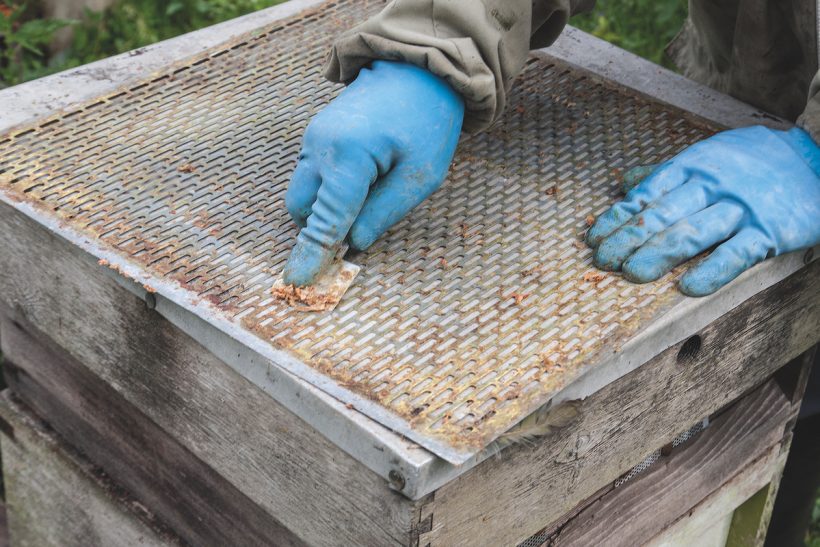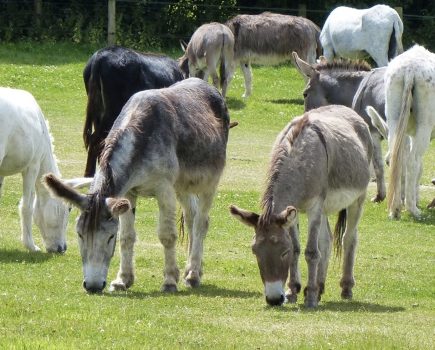With winter on the way, The Country Smallholder provides a checklist of tasks for beekeepers to tackle before spring arrives.
Winter is almost with us, and the active beekeeping season is over for another year. However, beekeeping activities don’t really have a beginning or an end. The fact that actions at any time of year have a bearing on the situation at another is one of the things that makes beekeeping interesting and challenging.
So, what is there to do while the bees are clustering in their hives? Winter is a time when tasks can be undertaken at times that suit the beekeeper, but it is easy to put things off and then find yourself in a panic in the spring when things suddenly become urgent.
Equipment
All your spare equipment is unoccupied by bees which makes winter an ideal time to inspect it and make any repairs.
Boxes
- Check for damage. Can it be repaired?
- Check for loose joints and that the box is square at the corners.
- Are all the boxes bee tight? Check they can be stacked without any gaps between them, especially at the corners.
- Check that runners and castellations are in the right position to maintain the bee space between boxes. A bee space that is too big will be filled with brace comb; one too small will be propolised. Ensuring bee space is accurate in all of your boxes will make your beekeeping life a lot easier.
- Clean all boxes thoroughly. Scrape surfaces clean of wax and propolis. Collect the scrapings on newspaper and burn them.
- Scorch wooden boxes with a blow torch or hot-air paint stripper until the surface
is a uniform coffee-brown colour. Be especially vigilant in the corners. - You can’t scorch poly hives but they still need disinfecting. The best available options are chemical disinfectants containing hypochlorite or caustic soda. Try on a small area first to check they will not cause damage.
- Wooden boxes can also be sterilised with 80% ethanoic (acetic) acid. This will kill the causative agents of Chalkbrood, Nosema and Amoeba, as well as all stages of wax moth, except pupae.
- Clean spare open-mesh floors so you can swap them readily for those on hives in the spring.
Frames
Frames cost £2–5 each which doesn’t sound a lot and with new frames, you are certain not to transmit disease. However, if you have more than a couple of hives, the cost can mount up so you may want to clean up old frames before inserting a new foundation just before you use them next year.
Scrape the frames as clean as possible, collecting and burning the scrapings as before. Tools are available from equipment suppliers to get down the groove in the side bar. Frames can be steam cleaned or boiled in a washing soda solution where a Baby Burco will fit the bill, but you may need to clean one-half of the frames and then reverse them to clean the other half if they won’t fit. Rinse the clean frames with water and leave them to dry.
- If you want to keep valuable drawn comb, frames can be sterilised with acetic acid.
- Check if frames are loose and add nails if necessary. Make sure they are square.
- Are the lugs damaged or weakened by levering with a hive tool? Frames
with damaged or weak lugs should be discarded so that you don’t end up with a broken lug during one of your inspections. Order some frame nails if your supply is running short. - Make sure the ‘V’ on Hoffman frames is still sharp or the bee space will be compromised.
- If you use plastic spacers, think about using different colours to, say, indicate the year the frame was brought into service. Colours could be coordinated with those used for queen marking.
Excluders
Excluders get bunged up with brace comb and propolis, so winter is a good time to clean and inspect them in case any of the gaps have got distorted, possibly allowing a queen through.
- Discard damaged excluders.
- Propolis on excluders left outside until the weather turns cold becomes brittle and easier to scrape off with a hive tool. Put the excluder on a firm flat surface before you start. Wire excluders can be scorched with a blow torch but be careful not to melt the solder joints. Zinc excluders can be scrubbed with a washing soda solution and plastic ones treated in the same way as poly hives.
Hive Stands
Are your hive stands still up to the job? They need to be sturdy and rigid. Legs should be placed on a solid surface such as a paving slab so that they don’t sink into the ground if it becomes soft during wet weather.
Storage
Having cleaned, mended, and sterilised your equipment, store it safely so that the weather, wax moth and rodents cannot gain access and ruin all your good work.
Tools
Clean out your toolbox. Is everything in good order? Clean the hive tool with a washing soda solution and check the edge for sharpness. Check the threads across a press-in queen marking cage to make sure none are broken.
- Scrape the soot from inside the smoker. Leave the barrel in washing soda solution for a few days to help remove the grime.
- Check there are no holes in the smoker bellows. Would it be useful to attach a hook so that you don’t have to put it on the ground during inspections?
- Do you need any kit for marking your queens? Buy it now and be prepared.
- Do you need more record cards? Print or buy them now.
Protective Clothing
- Are there any holes in your veil? Get them mended or buy a replacement hood!
- Wash your bee suit ready for the next season. Mend any holes and ensure the zip is working properly.
The Extractor
Clean your extractor and lubricate it, if appropriate. Check the valve and order a new O-seal if necessary.
- Wash your filter cloth(s) and buy new ones if necessary.
- Clean and check your uncapping tray. Does the valve work properly?
- Is your uncapping knife or fork still fit for purpose or does it need renewing?
In the Apiary
Winter is a good time to work in the apiary. Cut back undergrowth and make sure hive entrances are clear. Assess whether you need to kill weeds in any problematic areas in the spring.
Check the apiary periodically. Hives can fall over; roofs can be blown off and woodpeckers and rodents can do damage. Heft hives regularly and feed colonies candy if necessary.
If you want to rearrange hives, do so when a cold spell is forecast. Prepare the new site first and, if possible, ask a fellow beekeeper to help so that the colony is disturbed as little as possible during the move.
Decisions, Decisions
The colder, darker months offer an opportunity to sit down and look back as well as plan for the future. Record cards will show you which colonies performed closest to your targets. Which produced the most honey? Was there any particular reason? Which bees were the calmest
on the combs when you examined them? Which followed you (or not) when you left the apiary? Which produced a lot of propolis? Is this a good thing or a bad thing? Which showed signs of disease such as chalkbrood?
From your records, you can plan for next season. Which colony/ies do you want to breed from? Which do you wish to unite or cull? Which ones should be moved to a different place in the apiary? Having made your plans, you can assess if you need to acquire any additional equipment.
If you are going to raise some queens, have you got enough nucleus boxes to house them? Which method are you going to use? Do you need special equipment or adapt existing frames? If you are going to graft, have you got a grafting tool?
What about swarm control? Does your chosen method use additional boxes? Have you got enough?
Have you got Sufficient Frames?
What about foundation? Have you accumulated sufficient wax to exchange it for foundation from one of the equipment suppliers? Are you going to the BBKA Spring Convention where suppliers offer wax exchange? If not, do you know someone who is? Does your Local Bee Club collect wax so it can get a better deal on foundation?
How are you going to acquire the equipment you need next year? Will you make it from scratch, possibly using recycled timber? Can you put together a flat-pack hive or will you purchase one that is ready to go? Wooden or poly hives?
Time to Relax
Having assessed and mended your equipment, decided on your beekeeping plan for 2024 and worked out what additional equipment you need, what are you going to do with all that spare time? Why not use it to increase your beekeeping knowledge? You don’t have to aim to take the BBKA module examinations, although studying for them is a good discipline that forces you to learn things that you would otherwise ignore. The better you understand your bees and their behaviour, the more interesting and better your beekeeping will be and that, surely, must be the aim of us all.
Winter is the time for sitting by the fire, reading a good (bee) book, and enjoying a glass of mead! Now, there’s something else you can make in your spare time this winter, and don’t forget cleaning your beeswax and making a candle or two!
Image Caption – Leave metal excluders outside in the cold weather to turn the propolis brittle and make it easier to remove. Place on a flat surface before scraping with a hive tool being careful not to distort any of the gaps.
To receive regular copies of The Country Smallholder magazine featuring more articles like this, subscribe here.
For FREE updates from the world of smallholding, sign up for The Country Smallholder newsletter here.








